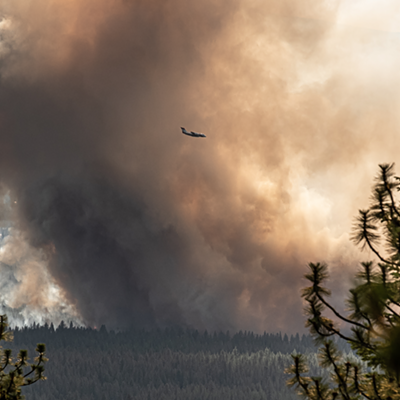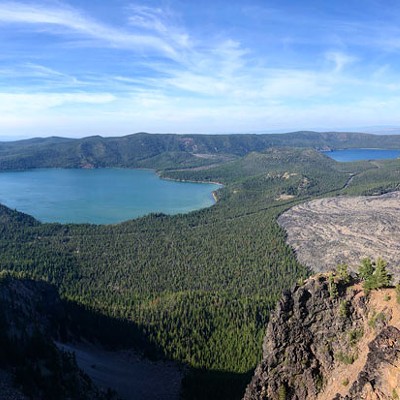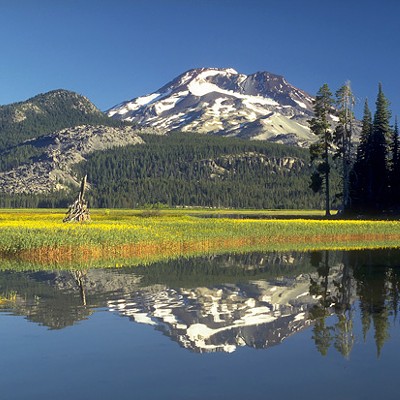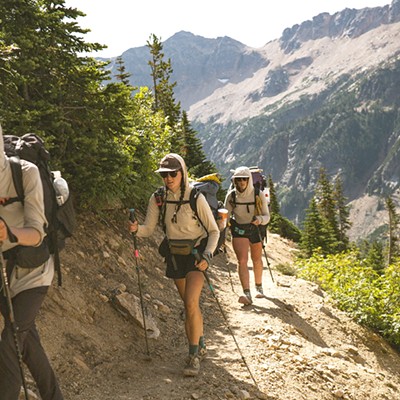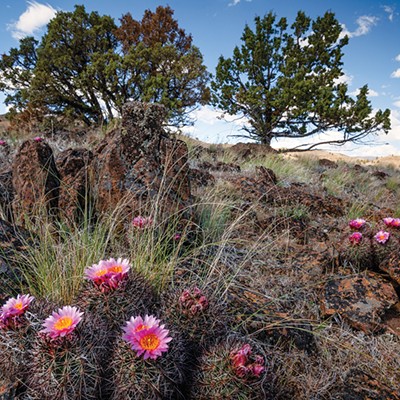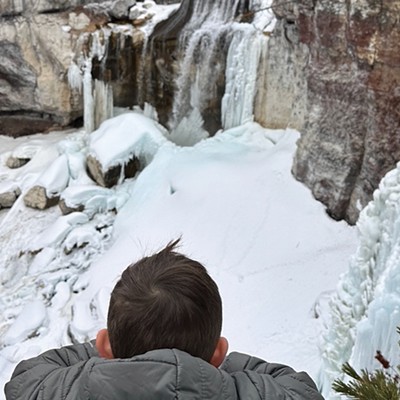Humans have been drawn to water since time immemorial, and Central Oregonians are no exception. That's why locals and tourists alike are eager to see the completion of the Deschutes River Trail, which currently spans more than 30, somewhat disjointed, miles from Sunriver to Tumalo.
Steve Jorgensen is the man with the plan. His days are filled with interactions Deschutes River Trail stakeholders, including representatives of state and federal lands, private property owners, home owner's associations, and local businesses.
As the Bend Park and Recreation trail planner responsible for the Deschutes River Trail, Jorgensen is working hard to help complete the trail that follows the river, sometimes closely, other times not, from Sunriver in the south to Tumalo State Park in the north.
Along with Oregon State Parks and the Deschutes National Forest, Bend's parks department is the trail's steward, mainly responsible for the segments contained within Bend's Urban Growth Boundary.
"The City of Bend, and the surrounding areas of Tumalo to Sunriver are fortunate to have the Deschutes River as an integral and accessible part of its recreational opportunities," Jorgensen says.
Even in regions with major rivers, residents don't always enjoy such easy access. In Concord, New Hampshire, for example, the entire downtown has its back to the mighty Merrimack River. But the state's major interstate, I-93, stands in the way of easy recreational access. In Central Oregon, it can be easy to complain about less than complete access, despite the relative bounty. But when the process is complete, the trail will have full connectivity from Sunriver to Tumalo.
The Tumalo terminus
Because the Deschutes River flows south to north, the trail technically begins in Sunriver, at Benham Falls. However, for many trail users, Bend serves as a starting point from which the trail branches out to the north and south.
The northern, downstream terminus of the trial spills into the expansive lawns of Tumalo State Park, a sparsely-used segment of the trail due to a large boulder field that blocks the path between it and the Riley Ranch Nature Preserve.
Although currently closed to the public, Riley Ranch is a 184-acre regional park with planned facilities that will include a bridge, parking, shelters, and interpretive exhibits.
The ranch was purchased by the parks department in three acquisitions between 2010 and 2013, and the land features open meadows, juniper and pine forests, unique lava flows, cliffs, and the river's rocky canyon.
The property is upstream of Tumalo State Park and provides access to the Deschutes River Trail south to Archie Briggs Canyon on Awbrey Butte, eventually extending to Pioneer Park in downtown Bend.
When I first moved to Central Oregon, I lived in downtown Tumalo. As a runner, the first thing I looked for was a place to run, initially limiting myself to O.B. Riley and Johnson Roads. In search of off-road trails, I ventured down Riverview Road, discovering a single-track trail that led under Highway 20. I was surprised to find that it took me to Tumalo State Park, where I still connected to Johnson Road, having no idea that the Deschutes River Trail ventured this far downstream.
On an adventurous day, I proceeded through the day use area until I came upon a private driveway with a bridge that crossed the river. This is where I turned around, again not knowing that the trail continued from here.
After my first winter, when the ice had melted on the trail, I ventured further, to discover the trail continuing on the upstream side of that private bridge, following the river. The first gap in the trail is encountered along this section, a part of the trail that falls under the auspices of Oregon State Parks.
In early August, Jorgensen met with representatives of the park system to discuss options for traversing the boulder field, subsidized by a $192,000 grant they have in-hand to spend on this project over the next five years.
"The consensus was to widen the trail out to the boulder field to allow access for equipment to the site," explains Jorgensen. "They would then build a boardwalk across sections of the boulder field that could not be crossed with rock infill."
Efforts to bridge this gap highlight the capacity issues that Jorgensen must continually balance. While access across the boulder field is desired, doing so will increase traffic to, and through, Riley Ranch, which is yet to open, pending improvements estimated to be complete in the spring of 2016.
The in-town trail
Within Jorgensen's direct purview are four main sections of trail starting with its northernmost point at Kirkaldy Court off of Putnam Road, traversing Archie Briggs Canyon on its way to Mt. Washington Drive. Crossing the road and heading up the hill takes those on the trail to First Street Rapids joining the river for a wide and mostly flat section. The footbridge near the small First Street parking lot continues the trail to Pacific Park where the trail officially terminates for a short section. This is the where Jorgensen identifies another gap in the trail, separating trail users from the downtown section, a gap he refers to as the "Pacific Park to Drake Park segment."
"Draft concepts for this section of the trail have been refined by our consulting team and are being presented to adjacent property owners for comments," he says. "There are three owners out of six total properties from whom trail easements are needed." Jorgensen says he has received tentative easement approval from most, but further development planning remains, contingent on Mirror Pond development.
"We really do not want to move forward with any trail improvements without knowing the future of Mirror Pond," he explains. "With that and the future of the dam still undecided, the trail will continue to go around that area."
Now that I live in downtown Bend, I enjoy the benefit of being able to "run out the door" to the trail. One of my routes takes me through downtown to connect with the trail at the Newport Bridge and on to First Street Rapids. Within a few miles, I enjoy urban scenery, the relative early morning quiet of downtown, the river itself, early-bird golfers, and Awbrey Canyon, all making for an enjoyable out-and-back traffic-free workout on leg-friendly surfaces.
The most urban component of the trail winds through downtown along Drake Park and city streets (mainly Riverfront) to Miller Park on the east side or McKay Park on the west, depending on the choice of bridges to cross.
Jorgensen explains that the Riverfront Street section of trail is slated for a number of improvements that include calming and more accurately directing vehicle traffic, sidewalk improvements, and Americans with Disabilities Act compliance, and a redesign of the Gilchrist Alley and pedestrian bridge that connects to Columbia Park.
"We have a preliminary design for improvements around that footbridge that would essentially extend Columbia Park down to the bridge," says Jorgensen. "And, road work will more easily direct traffic to avoid the dead end at Miller Park."
At this point, the trail runs headlong into the Colorado Dam project, slated for completion this month. The construction currently requires trail users to walk up the hill on NW Carlon Avenue to Colorado Avenue to cross at the traffic light before picking up the trail behind Tumalo Creek Kayak & Canoe.
Jorgensen is looking forward to bridging this particular gap in the fall, something he feels will prove popular in the long run but, potentially, not so much in the short term.
"Soon after the whitewater park is complete, we will start work on the Colorado tunnel project," Jorgensen explains. "At that time, the road will be closed in both directions as it will be cut to drop in a prefabricated tunnel."
Jorgensen anticipates that construction will begin in September with the road closure scheduled for early October and lasting into mid-November. Improvements will also be made to the portion of the trail that winds behind Tumalo Creek Kayak & Canoe, including a paved surface to connect it to the Old Mill.
"Patience will be needed for a short time," admits Jorgensen. "But, the Colorado tunnel will be a huge benefit to trail users."
Anyone who has ever hit their head on the pipes running underneath Colorado would agree with him.
The Old Mill section of the trail may be the only section seen by a majority of visitors to Bend, but the section between Colorado and the Bill Healy Memorial Bridge provides a wide variety of running opportunities. The popular Riverbend and Farewell Bend parks are along this section, offering rest rooms, tables, benches, and ample grassy areas. Easy access to the river, starting points for floating the river, numerous 5k and 10k road races, and rental bike usage takes place along this stretch. When running, I often head to this section when sure-footing is desired. Runs of infinite length can be concocted by crossing any of the bridges resulting in 3-6 mile out-and-backs. Just don't plan your runs during concerts at the Les Schwab Amphitheater when portions of the trail are closed.
The final frontier
The last easily accessible portion of the trail within the UGB, known as the Mt. Bachelor Village Trail, brings trail users to the South Canyon footbridge from the Bill Healy Bridge. The trail adjoins both sides of the river, connected via the footbridge 1.5 miles upstream. This section is for those on foot only, as cyclists are redirected up to Century Drive to the Haul Road Trail on its south side.
It is at this point that Jorgensen is presented with his biggest challenge—connecting the trail to the National Forest portion at Meadow Camp, known as the South UGB segment.
Currently, users must walk up Reed Market Road from the Bill Healy Bridge to the Haul Road trail adjacent to Century Blvd. The trail continues with a wide and easily traversed surface to the Entrada Lodge where trails take you back down to the Deschutes.
Jorgensen explained that the river from South Canyon and upstream is designated as a State Scenic Waterway, which means that no bridges are allowed.
"This section of the Deschutes and a section of the Metolius are the only two rivers in the state so designated," says Jorgensen. "We feel we have an argument to amend that language to say no to vehicle bridges, but allowing for bike and pedestrian bridges."
Outside of the UGB, the river's designation comes under federal control where bridges are allowed, but Jorgensen must then be able to document the potential increased usage of the trails if such a bridge were installed.
"When crossing federal lands, bridges are allowed but there are federal requirements to obtain a special use permit, which requires addressing all types of factors," he says, adding that this designation applies to the trail from the UGB boundary to Benham Falls.
The parks department's Citizens Advisory Committee has evaluated five conceptual bridge locations and eight trail options over the past year, Jorgensen says, and has passed on its recommendation to the Park District Board, calling for a bridge to cross the river just south of the UGB on federal lands.
Despite the challenges of closing the remaining gaps in the trail, Jorgensen remarked that the trail has come a long way since the first section was constructed near Awbrey Butte in 1989.
Although Jorgensen looks forward to imminent improvements near Miller Park and for crossing Colorado, he knows that patience will be required for extending the trail south of the UGB.
"This section could be constructed in the next three years, or it could be 10 years," he says. "We will be dealing with state and federal jurisdictions no matter what we do."


